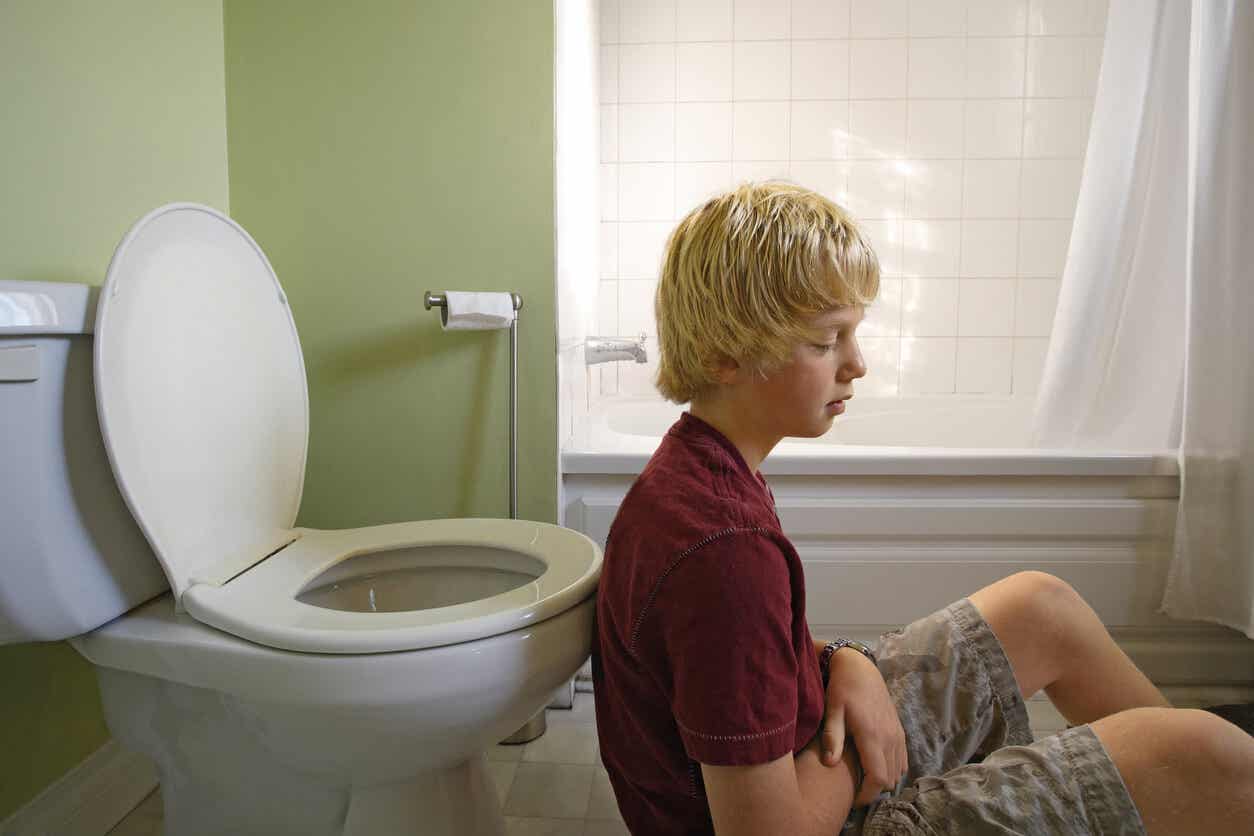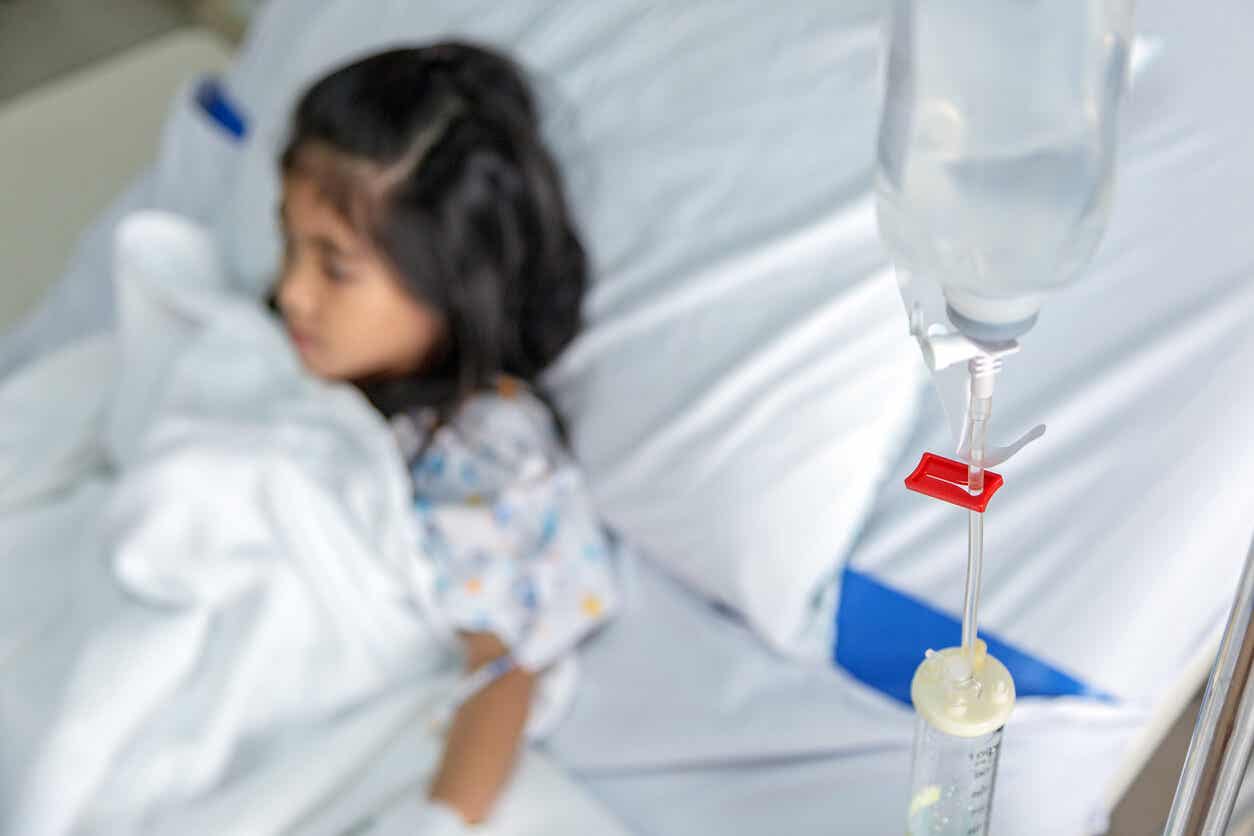How to Prevent Dehydration in Children and What to Do

During hot weather, fluid loss through sweating increases, and this increases the risk of dehydration in children. This health condition is potentially dangerous if measures aren’t taken in time. Therefore, it’s essential to teach parents how to prevent it.
It’s important to note that children have two special conditions that make them more vulnerable to dehydration:
On the one hand, they tend to maintain a higher activity level than their elders and this translates into greater sweating. On the other hand, the smaller they are, the less total body water they have. This means that, in the event of minimal losses, such as vomiting, the impact on their organism is more severe than in the case of an adult.
Therefore, it’s important to replace sufficient amounts of fluid in the event of loss in order to avoid imbalances that may affect the health of the child.
What are the signs of dehydration in children?

The main risk factors for dehydration in children are diarrhea, vomiting, heat, excessive sweating, and lack of access to drinking water. Typically, when a child becomes dehydrated, they may display the following symptoms:
- Dry mouth
- Absence of tears
- Sunken eyes
- Reduced urine volume
- Dry skin
- Irritability
- Drowsiness or dizziness
How to treat dehydration?
It’s essential that you identify dehydration in a timely manner in order to implement an appropriate fluid replacement strategy. When this starts at home, the risk of progression to severe dehydration is lower, and the chances of the child requiring hospital care decrease.
The ideal liquid to replace fluid losses in children is an oral rehydration solution, In addition to water, this solution consists of the right amounts of mineral salts and sugars. You can purchase this product at any pharmacy without a prescription and should be given within 3 hours from the onset of losses.
You should start with small volumes repeatedly. For example, 10 milliliters every 2 to 3 minutes, usually with the help of a syringe. The goal should be for the child to receive about 250 milliliters within one hour.
If the child accepts the salts well, you can increase the volume gradually. The important thing is to avoid vomiting, especially when dehydration is secondary to gastroenteritis.
It’s important to note that infants can maintain breastfeeding during the rehydration process. However, if the child receives formula milk, it should be replaced by a special formula for these cases (such as partially hydrolyzed or lactose-free formula).
At the same time, it’s important to avoid rehydrating a child with mineral water, juices, soft drinks, or broths, as these types of drinks don’t have an appropriate proportion of mineral salts and sugars for this purpose. And, many times, they can even worsen gastrointestinal symptoms.
In the most severe cases, intravenous administration of liquid will be chosen, but the emergency specialists should be the ones to make this decision.

How to prevent dehydration?
To prevent dehydration, you need to make sure that the child consumes water frequently, especially on very hot days. Also, if the child is suffering from an illness that involves vomiting or diarrhea, the replacement of liquids by mouth will be part of the treatment.
If the child refuses to drink liquids because of pain (for example, in the throat or abdomen), a common analgesic such as acetaminophen or ibuprofen can be offered. However, in this situation, you should consult a specialist in order to rule out more severe illnesses.
It’s important to respond correctly in the case of dehydration in children
According to what we’ve said, it’s crucial that you identify early the signs of dehydration and respond as soon as possible. Otherwise, the condition may progress, meaning you’ll need to take a trip to the emergency department to replace fluids intravenously.
Special care should be taken with fluid intake during the summer, as the risk of dehydration is higher. Also, in case of diarrhea or vomiting, you must be very attentive to the child’s symptoms to avoid reaching critical situations that could put their health at risk.
During hot weather, fluid loss through sweating increases, and this increases the risk of dehydration in children. This health condition is potentially dangerous if measures aren’t taken in time. Therefore, it’s essential to teach parents how to prevent it.
It’s important to note that children have two special conditions that make them more vulnerable to dehydration:
On the one hand, they tend to maintain a higher activity level than their elders and this translates into greater sweating. On the other hand, the smaller they are, the less total body water they have. This means that, in the event of minimal losses, such as vomiting, the impact on their organism is more severe than in the case of an adult.
Therefore, it’s important to replace sufficient amounts of fluid in the event of loss in order to avoid imbalances that may affect the health of the child.
What are the signs of dehydration in children?

The main risk factors for dehydration in children are diarrhea, vomiting, heat, excessive sweating, and lack of access to drinking water. Typically, when a child becomes dehydrated, they may display the following symptoms:
- Dry mouth
- Absence of tears
- Sunken eyes
- Reduced urine volume
- Dry skin
- Irritability
- Drowsiness or dizziness
How to treat dehydration?
It’s essential that you identify dehydration in a timely manner in order to implement an appropriate fluid replacement strategy. When this starts at home, the risk of progression to severe dehydration is lower, and the chances of the child requiring hospital care decrease.
The ideal liquid to replace fluid losses in children is an oral rehydration solution, In addition to water, this solution consists of the right amounts of mineral salts and sugars. You can purchase this product at any pharmacy without a prescription and should be given within 3 hours from the onset of losses.
You should start with small volumes repeatedly. For example, 10 milliliters every 2 to 3 minutes, usually with the help of a syringe. The goal should be for the child to receive about 250 milliliters within one hour.
If the child accepts the salts well, you can increase the volume gradually. The important thing is to avoid vomiting, especially when dehydration is secondary to gastroenteritis.
It’s important to note that infants can maintain breastfeeding during the rehydration process. However, if the child receives formula milk, it should be replaced by a special formula for these cases (such as partially hydrolyzed or lactose-free formula).
At the same time, it’s important to avoid rehydrating a child with mineral water, juices, soft drinks, or broths, as these types of drinks don’t have an appropriate proportion of mineral salts and sugars for this purpose. And, many times, they can even worsen gastrointestinal symptoms.
In the most severe cases, intravenous administration of liquid will be chosen, but the emergency specialists should be the ones to make this decision.

How to prevent dehydration?
To prevent dehydration, you need to make sure that the child consumes water frequently, especially on very hot days. Also, if the child is suffering from an illness that involves vomiting or diarrhea, the replacement of liquids by mouth will be part of the treatment.
If the child refuses to drink liquids because of pain (for example, in the throat or abdomen), a common analgesic such as acetaminophen or ibuprofen can be offered. However, in this situation, you should consult a specialist in order to rule out more severe illnesses.
It’s important to respond correctly in the case of dehydration in children
According to what we’ve said, it’s crucial that you identify early the signs of dehydration and respond as soon as possible. Otherwise, the condition may progress, meaning you’ll need to take a trip to the emergency department to replace fluids intravenously.
Special care should be taken with fluid intake during the summer, as the risk of dehydration is higher. Also, in case of diarrhea or vomiting, you must be very attentive to the child’s symptoms to avoid reaching critical situations that could put their health at risk.
All cited sources were thoroughly reviewed by our team to ensure their quality, reliability, currency, and validity. The bibliography of this article was considered reliable and of academic or scientific accuracy.
- Santillanes G, Rose E. Evaluation and Management of Dehydration in Children. Emerg Med Clin North Am. 2018 May;36(2):259-273. doi: 10.1016/j.emc.2017.12.004. Epub 2018 Feb 10. PMID: 29622321.
- Lacey J, Corbett J, Forni L, el at. A multidisciplinary consensus on dehydration: definitions, diagnostic methods and clinical implications. Ann Med. 2019 May-Jun;51(3-4):232-251. doi: 10.1080/07853890.2019.1628352. Epub 2019 Jun 17. PMID: 31204514; PMCID: PMC7877883.
This text is provided for informational purposes only and does not replace consultation with a professional. If in doubt, consult your specialist.








